E-Archive
Science Update
in Vol. 6 - May Issue - Year 2005
The Effect Of Cold Work On The Thermal Stability Of Residual Compression In Surface Enhanced IN718

Author: Paul S. Prev
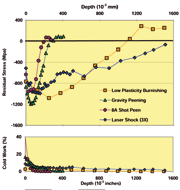
Figure 1: Subsurface residual stress and cold work distributions produced by shot peeing (8A, 200%), gravity peening, LSP (3X), and LPB in IN718.

Figure 2: Effect of exposure time at 525C on residual stress distributions in shot peened (10A, 200%) IN718.
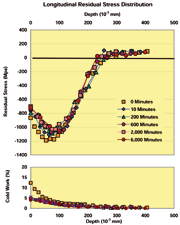
Figure 3: Effect of exposure time on residual stress distributions in gravity peened IN718 at 525C.
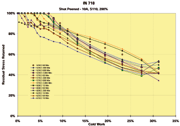
Figure 4: Fraction of compression retained after exposures to temperatures from 525C to 670C for times ranging from 10 to 2000 minutes for shot peened (10A, 200%) IN718.
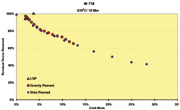
Figure 5: Correlation of cold work and fraction of stress retained in shot peened, laser shock peened and gravity peened IN718 after 10 minutes at 670C.
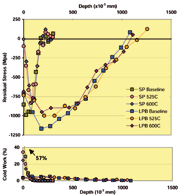
Figure 6: Relaxation of residual stresses in IN718 LPB processed and shot peened (10A, 400%, CW14 ) after 525 and 600C for 10 hr.
Introduction
Surface enhancement is widely used to improve the fatigue life of components by creating a surface layer of compressive residual stress that delays fatigue crack initiation and retards small crack propagation. However, the benefits of surface enhancement are lost if the compressive layer relaxes at the operating temperature of the component. Surface enhancement methods producing minimal cold work are shown to produce the most thermally stable compression.
The residual stress and cold work distributions developed in IN718 by shot peening, gravity peening, laser shock peening (LSP) and low plasticity burnishing (LPB) are compared. Thermal relaxation at temperatures ranging from 525C to 670C is correlated to the degree of cold working, independent of the method of surface enhancement. Highly cold worked (>15%) shot peened surfaces relax to half the initial level of compression in only minutes at all temperatures investigated. The rapid initial relaxation is shown to be virtually independent of either time or temperature from 525C to 670C. High cycle fatigue (HCF) performance after elevated temperature exposure is compared for surfaces treated by LPB and conventional (8A intensity) shot peening.
Since the introduction of shot peening, the HCF life of components has been improved by “surface enhancement” to induce a surface layer of compressive residual stress. The compressive layer resists both crack initiation and small crack propagation, and the subsurface residual stress has long been correlated with improved HCF strength.[1-2] However, if the residual compression relaxes during service, the fatigue benefits are lost. Risk of relaxation prevents designers from “taking credit” for the benefits of surface enhancement. Of the three mechanisms for residual stress relaxation: thermal, overload, and cyclic, only thermal relaxation is significant for nickel base superalloys in HCF limited applications. This paper summarizes research of the thermal stability of surface enhancement methods applied to the nickel base superalloy, IN718.
Surface Enhancement Methods
All mechanical surface enhancement methods create a layer of compressive residual stress by tensile deformation of the surface, but differ in the magnitude and form of the resulting residual stress and cold work (plastic deformation) distributions produced. The residual stress and cold work distributions produced by conventional shot peening, gravity peening, laser shock peening (LSP), and low plasticity burnishing (LPB) of IN718 are compared in Figure 1. Surface compression is comparable, but the compressive depths differ by an order of magnitude. Cold working ranges from 40% at the shot peened surface to a few percent for LPB.
The depth of the compressive layer and the degree of cold working produced by shot peening depend upon the peening parameters: shot size, velocity, coverage, and impingement angle. Shot impact stretches the surface in tension, leaving a compressive dimple. Because shot impacts are random, peening results in multiple overlapping impacts [3] and a surface highly cold worked from 10% to 50%.[4] Cold work is accumulative, and increases with coverage or repeated shot peening applications. The depth and degree of cold working increase with peening intensity. Surface compression may decrease during shot peening of work hardening alloys as the yield strength of the surface increases with continued cold working.
Gravity peening utilizes the same mechanism as shot peening, but employs fewer impacts of larger shot, producing less cold work and improved surface finish. Compression comparable to shot peening is achieved with 5 to 10% cold work.
Conventional roller or ball burnishing and “deep rolling” tools are pressed into the surface of the work piece with sufficient force to deform the near surface layers with multiple passes, often under increasing load, to improve surface finish and cold work the surface for improved strength. Fatigue enhancement is attributed to improved finish, the development of a compressive surface layer, and the increased yield strength of the cold worked surface.[5-24] X-ray diffraction line broadening and micro-hardness studies of deep rolling reveal cold work even greater than shot peening.[25-27]
Laser shock peening (LSP) [28] has been applied to a variety of alloys including titanium, nickel superalloys, and steels.[29] LSP produces a compressive layer of comparable magnitude to shot peening, but much deeper with less cold work. Single shock LSP can produce high surface compression with less than 1% cold work, affording excellent thermal stability in IN718.[30] However, multiple laser shock cycles are required to produce compression to depths of 1mm (3X in Figure 1), accumulating cold work to 5-7%.[31]
Low plasticity burnishing (LPB) produces a deep layer of high compression, comparable to LSP, but with improved surface finish, lower cost, and minimal cold work [32], typically an order of magnitude lower than deep rolling and conventional burnishing. The material, heat treatment, processing and testing details have been described in detail previously. [33]
Thermal Relaxation
Cold work from surface enhancement has been correlated with both the speed and magnitude of thermal relaxation of surface compression.[30] The rate and amount of stress relaxation for 10A, 200% shot peening and gravity peening, differing primarily in the amount of cold work developed, are shown in Figures 2 and 3 for exposures to 525C from 10 to 2000 minutes. Research in steel confirms that shot peening surface compression initially relaxes very rapidly, and then predictably with time and temperature.[34] Highly cold worked shot peened IN718 surfaces can relax to less than 50% of the initial value in only minutes at even low engine operating temperatures.[30]
The fraction of compression remaining after thermal exposure to temperatures from 525C to 670C for times ranging from 10 to 2000 minutes is plotted for shot peened IN718 in Figure 4. The relaxation of a variety of different surface enhancement methods after just 10 min. at 670C is plotted vs. cold work in Figure 5. The compression remaining after thermal exposure for any of the surface treatment methods is nearly independent of the temperature (for the 525C to 670C range examined), and only slightly dependent upon the time of exposure. Relaxation depends primarily upon the initial cold work and dislocation density. Dislocation annihilation appears to play a roll above a threshold level associated with nominally 3 to 5% cold work. Surface compression created with minimal cold work is clearly more stable at high temperatures. The data in Figures 4 and 5 indicates a cold work threshold for relaxation in IN718 to the order of 3% to 5%.
Residual stress and cold work distributions for shot peening and LPB exposed to 525C and 600C for 100h are shown in Figure 6. Compression at the shot peened surface relaxes nearly completely at either temperature, while the lightly worked LPB samples are stable. Only the subsurface maximum compression level is reduced to the alloy yield strength at the exposure temperature.
Conclusions
The compressive layer induced by shot peening of IN718 relaxes very rapidly at moderate turbine engine temperatures. Regardless of the surface treatment method, thermal relaxation depends strongly on the degree of cold work and dislocation density induced. Rapid initial relaxation is nearly independent of exposure temperature or time, and primarily a function of cold work above a threshold of a few percent. Surface enhancement methods such as LSP and LPB that produce minimal cold work, offer the greatest resistance to thermal relaxation.
References
[1] R., L. Mattson, and J.G. Roberts, “The Effect of Residual Stresses Induced by Strain Peening upon Fatigue Strength,” Internal Stresses and Fatigue in Metals, G.M. Rassweiler and W.L. Grube ed., New York, NY: Elsevier Pub. Co., (1959), pp. 348-349.
[2] W.P. Koster, et al. (1970), AFML Report AFML-TR-70-11, AFML, WPAFB.
[3] D. Lombardo and P. Bailey, “The Reality of Shot Peen Coverage,” The Sixth International Conference on Shot Peening, J. Champaign ed., CA, (1996), pp. 493-504.
[4] P. Prevéy, (1987), Residual Stress in Design, Process & Material Selection, ASM, Metals Park, OH, 11-19.
[5] W. Walters, (1980), Cutting Tool Engineering, 32, No. 5-6, pp. 15-16.
[6] Westerman, (1981), Proc. Deburring and Surface Conditioning 81, SME, Dearborn, MI, Report #MR81-401.
[7] G.R. Keessen, (1975), Cutting Tool Engineering, 27, No. 5-6, pp. 12-13.
[8] Cassatt, Tenclay, (1982), Proc. 1982 Joint Conference Experimental Mechanics, Part 1-2, pp. 1138-1145.
[9] P.A. Chepa, V.A. Andrayshin, (1973), Russian Eng. J., 53, No. 2, pp. 34-35.
[10] T. Nakamura, et al., (1993), JSME International Journal, 36, No. 4, pp. 348-353.
[11] V.A. Pyshkin, et al., (1986), Chemical and Petroleum Engineering, 22, No. 5-6, pp. 227-231.
[12] A.I. Lebedko, (1982), Met. Sci. Heat Treat., 24, No. 3-4, pp. 295-297.
[13] V.V. Belozerov, et al., (1986), Met. Sci. Heat Treat., 28, No. 7-8, pp. 565-569.
[14] V.T. Stepurenko, et al., (1976), Protection of Metals, 12, No. 4, pp. 386-389.
[15] D.D. Papshev, Yu G. Golubev, (1972), Russian Engineering Journal, 52, No. 4, pp. 48-51.
[16] M. K. Freid, et al., (1994), Protection of Metals, 20, No. 2, pp. 263-265.
[17] L.M. Belkin, et al, (1984), Soviet Engineering Research, 4, No. 9, pp. 30-32.
[18] L.M. Belkin, (1983), Soviet Materials Science, 19, No. 3, pp. 225-228.
[19] M. Fattouh, et al., (1988), Wear, 127, pp. 123-137.
[20] N.H. Loh, et al., (1989), Wear 129, No. 2, pp. 235-243.
[21] N.H. Loh, et al., (1993), Precision Engineering, 15, No. 2, pp. 100-105.
[22] B. Kotiveerachari, R.L. Murty, (1985), International Journal of Production Research, 23, No. 3, pp. 499-521.
[23] D.A. Hills, et al., (1979), Proc. Int’l Conference on Wear of Materials, ASME, New York, NY, pp. 396-402.
[24] S. Braham, J. Frelat, (1993),Proc. Computer Methods and Exp. Meas. for Surface Treatment Effects, Computational Mechanics Publications, Southampton, U.K., pp. 255-264.
[25] W. Zinn and B. Scholtes, “Mechanical Surface Treatments of Lightweight Materials - Effects on Fatigue Strength and Near-Surface Microstructures,” Journal of Materials Engineering and Performance, Volume 8(2), April 1999, pp. 145-151.
[26] I. Altenberger, et.al., “Cyclic Deformation and Near Surface Microstructures of Shot Peened or Deep Rolled Austenitic Stainless Steel AISI 304,” Materials Science and Engineering, A264, 1999, pp. 1-16.
[27] A. Drechsler, et.al., “Mechanical Surface Treatments of Ti-10V-2Fe-3Al for Improved Fatigue Resistance”, Materials Science and Engineering, A243, 1998, pp. 217-220.
[28] P. Foget, et al. (1990), Materials and Manufacturing Processes, 5, No. 4, 501-528.
[29] A.H. Clauer, “Laser Shock Peening for Fatigue Resistance,” Surface Performance of Titanium, J. K. Gregory et.al. eds., TMS, Warrendale, PA, (1996), pp. 217-230.
[30] P. Prevéy, et al., (1997), Proc. ASM/TMS Materials Week, Indianapolis, IN, Sept 15-18, 1997, pp. 3-12.
[31] P.R. Smith, M.J. Shepard et.al., “Effect of Laser Shock Processing (LSP) Power Density and Shot Repetition on Residual Stress Distributions and % Cold Work in Ti-6Al-4V,” Proceedings of the 5th Nat. Turbine Eng. HCF Conference, Chandler, AZ, 2000.
[32] U.S. Patent 5,826,453 (Oct. 1998), other patents pending.
[33] Paul S. Prevéy, “The Effect of Cold Work on the Thermal Stability of Residual Compression in Surface Enhanced IN718”, Proceedings of the 20th ASM Materials Solutions Conference & Exposition, St. Louis, MO, Oct. 10-12, 2000.
[34] B. Eigenmann, V. Schulze, and O. Vöhringer, (1994), Proceeding ICRS IV, pp. 598-607.
For Information:
Lambda Research
Chicinnati, OH, USA
Tel. +1.800.883 0851
www.lambdatechs.com



























